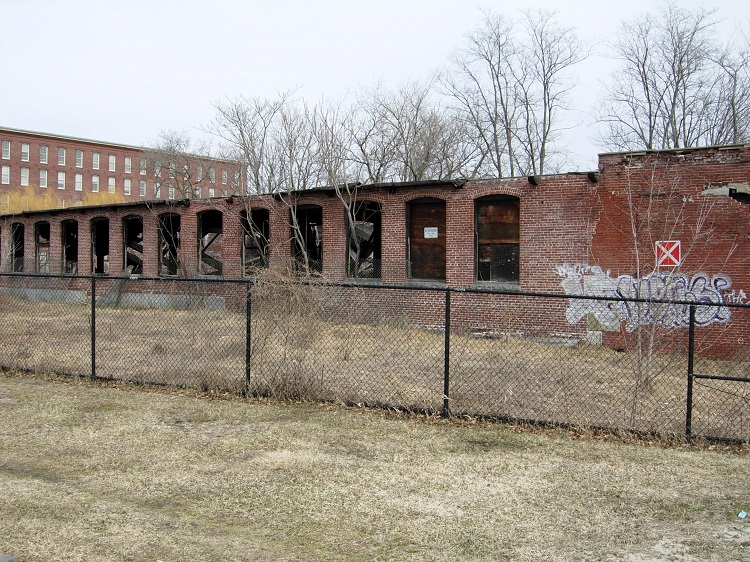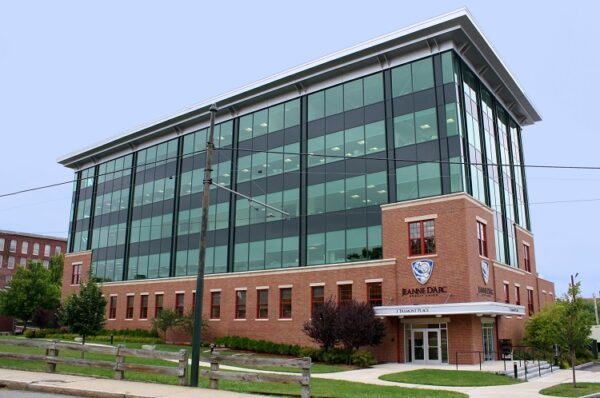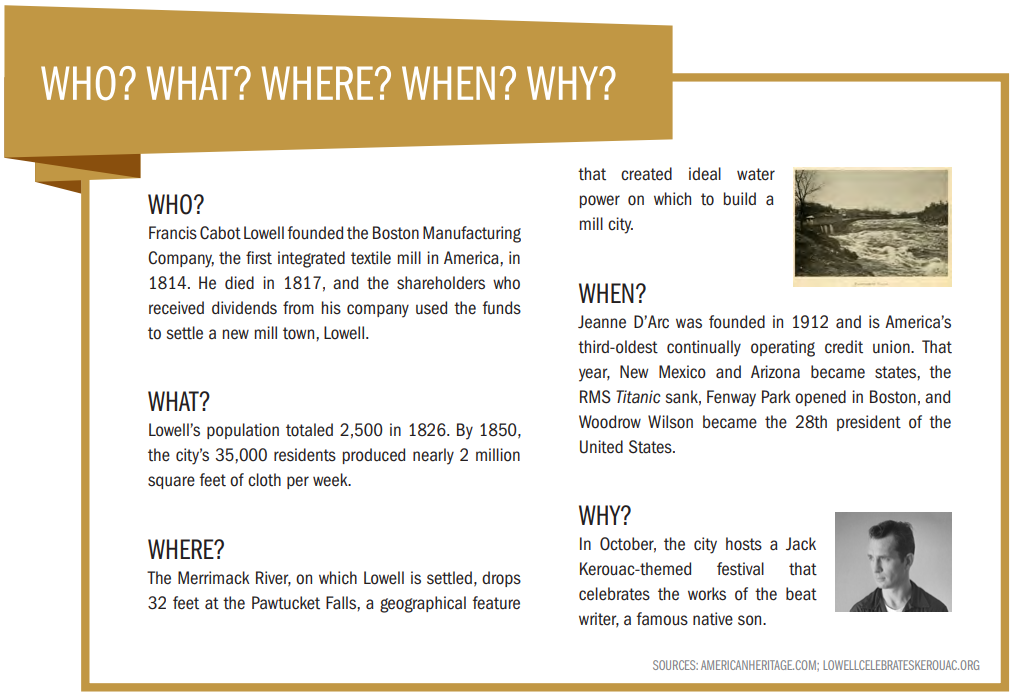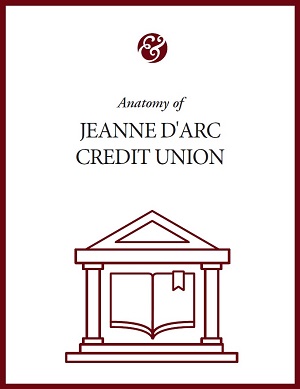The history of Jeanne D’Arc Credit Union ($1.4B, Lowell, MA) stretches back well before its founding in 1912.
In the early 1800s, textile manufacturing in the United States quickly grew from a cottage industry into a large-scale factory system that became the dominant industry of America’s Industrial Revolution. This was thanks in large part to Francis Cabot Lowell, who built the United States’ first integrated cotton spinning and weaving facility in Massachusetts in 1814.
In 1817, investors in the company of the now-deceased Lowell used their dividends to establish a mill town on the shores of the Merrimack River. Lowell, MA, became the first large-scale factory town in the country. The cradle of the American Industrial Revolution also became a hub of immigration and innovation.
“Lowell then was like Silicon Valley is today” says Mark Cochran, CEO of Jeanne D’Arc.
In 1912, the large French-American immigrant population that had settled into Lowell to work in the mills founded the nation’s third-oldest continually operating credit union and named it Jeanne D’Arc Credit Union after the French patron saint.
The Land Of Lowell
Lowell, MA, has 41 parks, buildings, and districts listed on the National Register of Historic Places. Despite this historical significance, the median household income for residents of the blue-collar city is less than the state average.
The Thread That Binds
Jeanne D’Arc is a low-income designated cooperative that diligently serves all of today’s members while paying homage to its industrial legacy. Its tagline says it all, We share a common thread.
“We’re based in the heart of where the industrial revolution started, where the mills spun cotton to make thread and yarn” says Michelle Silveria, the credit union’s senior vice president and chief marketing officer. “Jeanne D’Arc has always had a presence here.”
But the community-chartered credit union, which now serves 85 cities and towns that surround Lowell, hasn’t always so strongly embraced its past. For example, when Cochran became CEO in 2007, Jeanne D’Arc used the initials JDCU as its primary moniker.
“We had a history and we prided ourselves in saying we started in 1912, but we never really gave a nod to it” Silveria says.
Le Saviez-Vous
Until 1976, Jeanne D’Arc Credit Union conducted its board meetings in French.
One of Cochran’s early goals was to re-imagine the institution’s branding and recapture its storied history. The credit union wasn’t using its history to help employees and members understand what it meant to the community. So, through the help of an ad agency, the credit union updated its logo in 2007 with a modern image of Joan of Arc, reclaimed the name Jeanne D’Arc, and instituted its common thread tagline.
Jeanne D’Arc took the idea of building on its history to a whole new level in 2009 when it opened a new headquarters building at 1 Tremont Place.

Old Site. New Life.
As a planned manufacturing center for textiles, Lowell is built on a system of canals that powered the mills. At the intersection of the Northern and Western canals sat Tremont Yard, a series of underground tunnels built to experiment with using turbine power to run the mill that once stood on the floors above the powerhouse. It’s above this series of subterranean tunnels, which once generated electricity for the homes and businesses in its vicinity, that the headquarters of Jeanne D’Arc now stands.
Jeanne D’Arc’s first non-church headquarters was located on Cabot and Merrimack streets, just a block-and-a-half from the old Tremont Yard. The credit union moved away from this corner in 1936, but it returned in 1947 when it built a new headquarters. It remained there until the need for more space and resources forced Jeanne D’Arc to look for a new location. But even then, the credit union didn’t want to go far.
“We’ve always been here” says CEO Cochran. “It was important to us to keep our corporate headquarters in this neighborhood.”
Old Headquarters Site

New Headquarters Building

The credit union chose the old Tremont Yard as the new location for its headquarters, staking its claim as a local organization willing to commit to the neighborhood. The mill had burned down years earlier, and on the remaining foundation of the condemned building Jeanne D’Arc built a modern five-story brick headquarters in 2009. Photographs of 1800s-era Lowell hang within the building, and conference rooms and other shared spaces bear the names of historical landmarks.
“We’ve got a legacy that means something” Cochran says. “Building on this historical foundation fits our legacy.”
BEST PRACTICE: Hire For A Culture Of Service
“Jeanne D’Arc uses interviews and personality tests to spot service-driven employees. Building a culture of service starts in the hiring process” says Mark Cochran, CEO of Jeanne D’Arc.
The credit union works to build a legacy that extends beyond its efforts to physically revitalize downtown Lowell, however, as it also dedicates time, money, and resources to the communities it serves.
In 2017, more than 19,000 people attended the classroom-style financial health and wellness lessons presented by the credit union’s five-person financial education team. Additionally, 200 Jeanne D’Arc employees together logged 8,492 volunteer hours supporting 370 organizations. On an organizational level, the credit union donated more than $120,000 to 141 organizations from its own coffers and $210,000 to 92 organizations through its We Share A Common Thread foundation.
These efforts don’t go unnoticed, especially among local millennials and new generations of immigrants coming to the city — French and Irish 100 years ago; southeast Asians and Africans today. Jeanne D’Arc’s roots run as deep as the canals under the city, and it’s committed to the area and the people who live in it.
“We’re committed to staying on the street where we were founded and giving back to this area that’s been so good to us” says CMO Silveria. “People are shocked when I tell them about our history. They don’t believe we’re this old and still in Lowell.”

Anatomy Of Jeanne D’Arc Credit Union
This article appeared as part of Callahan’s Anatomy Of A Credit Union series. Read more in the Jeanne D’Arc series today.
